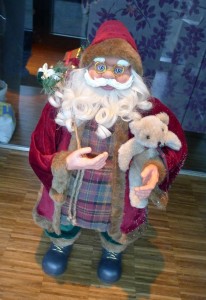We spent our Christmas holiday at Annette’s parents’ house in the small village of Lauenhagen, in northeastern Germany. Although this was not my first Christmas in Germany, it was my first here with children. Now that I speak a fair amount of German, it should have been simple for me to follow the rituals of Christmas here, but I have to confess that some of them still don’t make sense to me.
In America, we do a pretty good job of keeping Jesus and Santa Claus separate at Christmas time. We all know that Christmas celebrates the birth of Jesus, a drama that is re-enacted in still lifes and living crèches across the country. Perhaps we attend church on Christmas Eve to remember and celebrate the birth of Jesus. And on the night before Christmas, Santa Claus, who with his elves at the North Pole has been working all year long on presents for the good girls and boys, climbs into his heavily-laden sleigh and, led by the red-nosed Rudolph, circles the globe. He descends chimneys, delivers gifts, fills stockings, and downs milk and cookies. Pretty straightforward.
In Germany, at least in the areas I have been frequenting, there’s a different story circulating — one that I am having trouble grasping. Gifts are delivered sometime during the late afternoon of Christmas Eve. The deliveries are made by “Christkind” (the Christ Child), who is helped by “Der Weihnachtsmann” (Santa Claus). When I ask Germans how the Christ Child and the Weihnachtsmann get around the globe so quickly with all those gifts, they are evasive, and murmer that the Christ Child is sometimes depicted as having wings. So how do these co-conspirators get into the houses, and how do they know that nobody will be around when they do? Silence. Blank stares. The obfuscation and ambiguity are all the more curious coming from Germans, whom I have generally found to be very rational people.
Since I am a guest in their fine country, I am inclined to give Germans the benefit of the doubt. I am pursuing the theory that the Germans’ story of Christmas is a noble attempt to resist the commercialization of this holy holiday. The teaming up of baby Jesus with Santa Claus could be a metaphor for keeping the true spirit of Christmas alive. This may be the case, but frankly, I don’t see children buying it. Better to tell children the truth about Jesus and Santa Claus — that they are two sides of the same celebration — because at least the true stories make sense.
Despite the lack of a coherent, reasonable Christmas Story, Annette, our daughters and I had a fun and relaxing Christmas with Annette’s parents and relatives. The weather was too warm for snow, but we did go for a few lovely long walks and bike rides. I have posted numerous pictures in the Gallery called “Christmas in Lauenhagen.”

